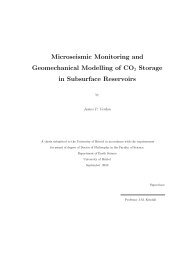MSAT - University of Bristol
MSAT - University of Bristol
MSAT - University of Bristol
Create successful ePaper yourself
Turn your PDF publications into a flip-book with our unique Google optimized e-Paper software.
toolkit we group the functions together according to how elasticity matrices<br />
appear in the lists <strong>of</strong> input or output arguments. In the first group <strong>of</strong><br />
functions elasticity matrices are created from the input arguments (Table 1).<br />
MS load and MS load list simply read data from input files (several data formats<br />
are supported) while MS elasticDB extracts elasticity information from<br />
a database included with the distribution. Other functions create elasticity<br />
matrices from summary information and a knowledge <strong>of</strong> the symmetry. For<br />
example, MS iso builds an isotropic elasticity matrix from the P- and S-wave<br />
velocities and density while MS TI creates a matrix with transverse isotropy<br />
and a vertical symmetry axis given, for example, the Thomsen parameters<br />
(Thomsen, 1986).<br />
It is also possible to model the effective anisotropic elasticity caused by particular<br />
rock fabrics; an effect that can be important even if all the components<br />
<strong>of</strong> the rock are isotropic on a short length scale compared to the seismic<br />
wavelength. For example, if an elastically isotropic medium contains aligned<br />
ellipsoidal inclusions filled with an elastically isotropic material <strong>of</strong> a different<br />
stiffness the effective elasticity is anisotropic. When the inclusions are axially<br />
symmetric the net effect is the creation <strong>of</strong> transverse isotropy (Tandon and<br />
Weng, 1984). A similar effect can arise from layering <strong>of</strong> isotropic materials <strong>of</strong><br />
different stiffness (Backus, 1962). This is a common occurrence in sedimentary<br />
basins where the beds have distinct lithology and thus elastic properties.<br />
The MS effective medium function allows the creation <strong>of</strong> elasticity matrices<br />
representing these cases.<br />
The second group <strong>of</strong> functions include elasticity matrices as input and output.<br />
These functions, listed in Table 2, are used to manipulate or transform an elasticity<br />
matrix. Simple examples <strong>of</strong> these functions are MS rot3, MS rotEuler<br />
13











